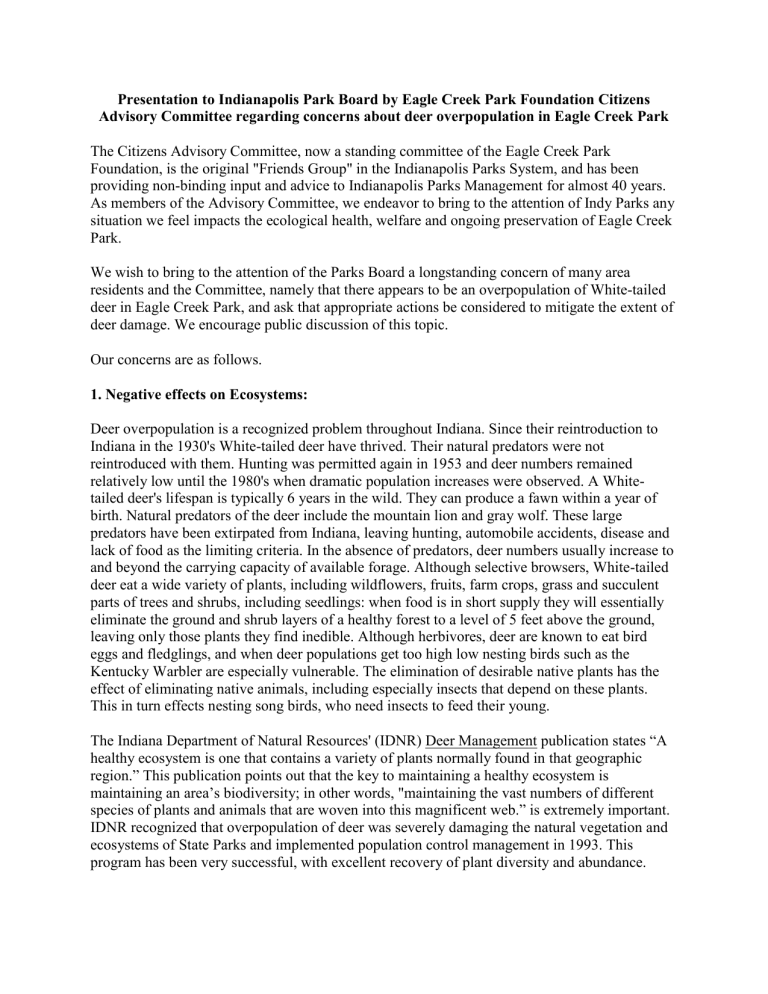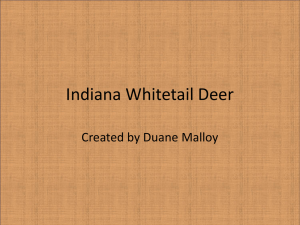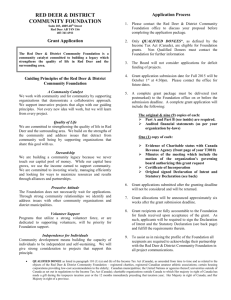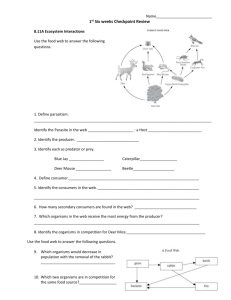Presentation to Indianapolis Park Board by Eagle Creek Park

Presentation to Indianapolis Park Board by Eagle Creek Park Foundation Citizens
Advisory Committee regarding concerns about deer overpopulation in Eagle Creek Park
The Citizens Advisory Committee, now a standing committee of the Eagle Creek Park
Foundation, is the original "Friends Group" in the Indianapolis Parks System, and has been providing non-binding input and advice to Indianapolis Parks Management for almost 40 years.
As members of the Advisory Committee, we endeavor to bring to the attention of Indy Parks any situation we feel impacts the ecological health, welfare and ongoing preservation of Eagle Creek
Park.
We wish to bring to the attention of the Parks Board a longstanding concern of many area residents and the Committee, namely that there appears to be an overpopulation of White-tailed deer in Eagle Creek Park, and ask that appropriate actions be considered to mitigate the extent of deer damage. We encourage public discussion of this topic.
Our concerns are as follows.
1. Negative effects on Ecosystems:
Deer overpopulation is a recognized problem throughout Indiana. Since their reintroduction to
Indiana in the 1930's White-tailed deer have thrived. Their natural predators were not reintroduced with them. Hunting was permitted again in 1953 and deer numbers remained relatively low until the 1980's when dramatic population increases were observed. A Whitetailed deer's lifespan is typically 6 years in the wild. They can produce a fawn within a year of birth. Natural predators of the deer include the mountain lion and gray wolf. These large predators have been extirpated from Indiana, leaving hunting, automobile accidents, disease and lack of food as the limiting criteria. In the absence of predators, deer numbers usually increase to and beyond the carrying capacity of available forage. Although selective browsers, White-tailed deer eat a wide variety of plants, including wildflowers, fruits, farm crops, grass and succulent parts of trees and shrubs, including seedlings: when food is in short supply they will essentially eliminate the ground and shrub layers of a healthy forest to a level of 5 feet above the ground, leaving only those plants they find inedible. Although herbivores, deer are known to eat bird eggs and fledglings, and when deer populations get too high low nesting birds such as the
Kentucky Warbler are especially vulnerable. The elimination of desirable native plants has the effect of eliminating native animals, including especially insects that depend on these plants.
This in turn effects nesting song birds, who need insects to feed their young.
The Indiana Department of Natural Resources' (IDNR) Deer Management publication states “A healthy ecosystem is one that contains a variety of plants normally found in that geographic region.” This publication points out that the key to maintaining a healthy ecosystem is maintaining an area’s biodiversity; in other words, "maintaining the vast numbers of different species of plants and animals that are woven into this magnificent web.” is extremely important.
IDNR recognized that overpopulation of deer was severely damaging the natural vegetation and ecosystems of State Parks and implemented population control management in 1993. This program has been very successful, with excellent recovery of plant diversity and abundance.
The Indiana Division of Fish and Wildlife has recently made changes to hunting regulations because of ongoing concerns regarding the overabundance of deer, deer/human conflicts and environmental damage. The intention is to increase the annual harvest. Marion County and the area of Hendricks County east of SR 267 are part of the Indianapolis urban deer zone. Bow hunting is permitted on private land from September 15th 2012 to January 31st 2013. One hundred and twenty nine thousand and eighteen deer were harvested in Indiana in 2011-2012.
The Nature Conservancy has recognized that responsible stewardship necessitates deer population control on many of their preserves. A recent Nature Conservancy publication points out that too many deer presents difficult choices for organizations dedicated to providing a haven for native species but that "--we cannot allow one species, in this case a large herbivore, to become so out of balance with its historic natural numbers that many plants found on our lands, including rare or endangered species are threatened with their very existence."
Eagle Creek Park contains two State Nature preserves, so designated because of their exceptional biodiversity. Unfortunately, the deer are no respecters of invisible boundaries, requiring a 7 foot fence to exclude them from an area. Numerous studies have been conducted on the herd size and extent of deer damage in Eagle Creek Park. An experienced and well respected deer researcher from Purdue, Dr George Parker and his team conducted a series of studies in the park for 5 years.
They used established research methods involving Jack in the Pulpit, Sweet Cicely and White
Baneberry as indicator plants, and also recorded the degree of browsing on woody plants. Dr
Parker and his colleagues observed heavy to severe over browsing on the East and West sides of the Park. They estimated a 5-10 fold deer overpopulation. A representative of IDNR recently estimated the current population to be approximately 10 times normal.
This overpopulation is associated with the same adverse natural consequences as observed in
State Parks and Nature Preserves throughout Indiana. Slow growing forest understory shade plants and spring wildflowers are most affected. Plants such as Trilliums that loose both flowers and leaves in one bite are especially susceptible. Eagle Creek Park has many fine mature Oak
Trees. Unfortunately deer preferentially graze on oak seedlings and there are very few young
Oaks to replace the mature trees when they die. Unpalatable aggressive alien plants such as
Asian Honeysuckle, are being preferentially encouraged over more desirable native species that support native insect populations and the birds and other animals that depend on them.
Information from a local resident indicates deer did not return to the Eagle Creek Park area until the early 1960's.
A common misunderstanding is thinking that Eagle Creek Park is a balanced self sustaining natural area that should be left to care for itself. This is unfortunately not true. It is too small an area, highly impacted by human activity both within and around the Park, and by invasive alien plant species. Natural predators such as the Grey Wolf, critical to maintaining a natural balance, have long been eliminated, and their reintroduction would be neither tolerated nor practical.
Coyotes, which do occur in the park, are not considered serious predators of White-tailed deer.
There has been considerable residential development around the Park in recent years, with a corresponding loss of arable farm land and the supplementary forage it provided. The Park's natural systems require careful, knowledgeable and responsible management if further degradation and decline of the natural ecosystems is to be avoided.
2. Health of Deer Herd
Since hunting is not allowed in the Park, the major factors limiting the deer population are old age, disease, lack of food and collisions with automobiles.
As mentioned above, unless limited by predation, a deer population will usually increase until food supplies are insufficient. At this point any factor causing a significant decrease in the amount of available food, such as extreme weather conditions, will result in debilitated animals and death due to starvation.
Overpopulation resulting in inadequate food sources led to stunted growth of deer in State Parks during the late 1980's. The malnourished deer were up to 30% underweight and many does were giving birth to only one fawn per year rather than the normal 2-3. The same trends are being observed in Eagle Creek Park.
Hungry deer are resourceful in seeking out food sources, and many animals browse in areas surrounding the Park. As previously stated, residential development around the Park in recent years has greatly reduced the acreage of agricultural land that previously acted as a buffer to accommodate deer. Roads around the Park have become more heavily travelled and as noted below, many deer are killed by cars when crossing busy thoroughfares. Homeowners are well aware of the frustrations associated with browsing deer destroying their landscaping.
3. Human Safety and Personal Property Issues:
Automobile accidents
Approximately 16,000 deer/vehicle accidents, almost 10% of the total number of accidents, are reported in Indiana each year. The actual number of deer related accidents may be higher, since not all accidents are reported, and accidents caused by drivers swerving to avoid a deer and colliding with something else may be included in other categories. Loss of life can and does occur.
Marion and Hendricks Counties (Hendricks County borders the west side of the Park) had a combined total of deer-vehicle collisions of 322 reported in 2010, 138 in Marion and 184 in
Hendricks County. A total of 61 dead deer were collected from the short stretch of I65 and I465 adjacent to the east side of the Park during an 11 month period ending August 2012. Fortunately none of these animals caused a major accident such as occurred October 28, 2011 when 7 people died on the Indiana Toll Road.
Deer are highly mobile. Overpopulation in Eagle Creek Park encourages deer migration outside the park to reach additional food supplies. Deer are usually most active in the evening and early morning, and are likely to cross major traffic thoroughfares during these times, times when driver visibility may be impaired.
Human Health considerations:
Cases of Lyme disease, carried by deer ticks, are now being reported in Central Indiana.
Although animals other than deer also act as host for the tick, an overabundance of deer can be expected to hasten the spread of this troublesome disease. (Addendum: Deer are also a host of the Lone Star tick, the second commonest tick in Indiana after the Dog Tick. The Lone Star tick is a carrier of the organisms causing Rocky Mountain spotted fever and Human monocytic ehrlichiosis.)
In summary, there is compelling evidence of an overabundance of White-tailed deer in Eagle
Creek Park. This overabundance is degrading the ecosystem, adversely affecting the park's native plants and animals, and presents a significant hazard for road users. We respectfully ask the
Board to urgently evaluate the need for appropriate control measures that will protect the long term biodiversity of the Park, and the health and safety of citizens in the area.
Circa December 2012





